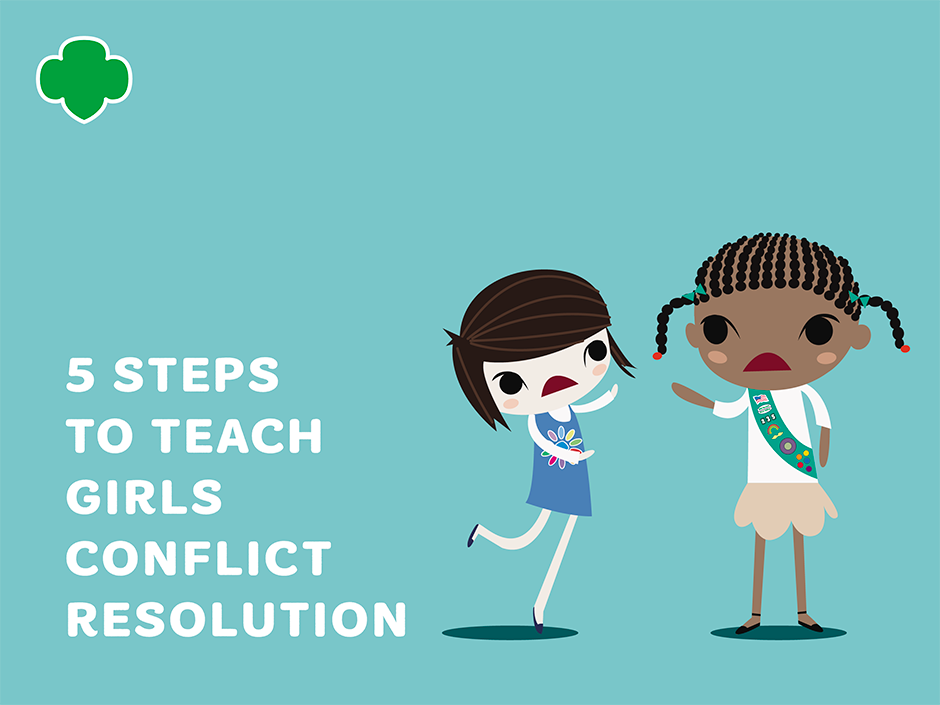
Everyone in your troop gets along like peas in a pod. When it’s time to partner up for an activity, girls pair off without squabbling about who gets to be with whom. You offer a few choices on how to complete one of the steps of their Think Like a Programmer Journey. Kalea wants to do it this way, but Freya would rather do it another way. Realizing they’re not on the same page, they have a frank discussion and come to a mutual agreement about how best to proceed.
Sorry, was I dreaming out loud? As much as we like to believe that girls are and will always be sisters to every Girl Scout, conflict within a troop is pretty common and natural. As with any group of people with different personalities, needs, and wants, disagreements will inevitably arise. This is especially true with younger girls who are still learning what it means to be a good friend.
The good news is, you don’t always have to be the one to mediate every single argument. Conflict resolution is a valuable skill, but many kids don’t have a chance to solve their own problems before an adult steps in. Of course, in the beginning, you as their troop leader will play a big part in guiding them through the process, but with practice, girls will develop the ability to resolve these conflicts on their own. Here are five steps to keep in mind to help girls work through their interpersonal issues.
Stop and Breathe
When something stressful—like an argument—arises, the limbic system of our brain takes over and primes our body to either fight or flee. It prevents us from thinking logically about a problem. Let girls know that it’s okay to have strong feelings like anger and frustration, but that they don’t always have to act on them. We can usually override our brain’s instinctual response by taking deep breaths. Invite girls to take long, slow breaths to calm down—count to five on the inhale and five again on the exhale—before they dig into their conflict.
Share and Listen
Everyone involved in the conflict should have a chance to say what they think happened. Giving everyone the opportunity to share their perspective also prevents girls from interrupting to argue their own case (“That’s not what happened!”) and shifts the focus away from assigning blame (“It’s Mara’s fault!”). Reiterate that when someone is talking, it’s the other person’s job to listen.
Check for Understanding
After everyone has shared, check for understanding by having girls summarize what the other person said. For example, girls can start with, “What I heard is…” or “I think you said…” and end with “Does that sound right?” or “Did I miss anything?” Going through this step ensures that everyone’s feelings and viewpoints are validated—even if not all parties agree about what actually happened.
Find a Solution
Encourage girls to work together to come up with a solution that feels good for everyone. You can use the prompt, “Do you have any ideas how we can solve this problem?” or “What’s a solution that would work for both of you?” As the adult, refrain from offering your own solutions unless girls are really stuck; this empowers girls to develop problem-solving skills.
Follow Up
Actions should follow words, so if girls have agreed to a solution, check in with them later on to make sure that each person held up their end of the deal. You can also ask if the solution worked out the way they wanted to, and what they can do if a similar argument comes up again.
It might also be helpful to include these conflict resolution steps as your girls work on their troop agreement. Setting the groundwork for how problems will be solved in the troop sets group expectations for and ownership of how sticky situations will be managed.
Conflict, whether we like it or not, is a part of life. But equipping your girls with the tools to resolve these conflicts does more than just teach them how to work through a problem; it also shows them how to self-regulate, be empathetic, and take responsibility for their actions—all essential skills that will serve them well in the future.
 Lily Yu –Lily is a Program Resource Specialist at River Valleys. She earned her BA in comparative literature and Japanese from Hamilton College and has a background in publishing and advertising. Though she wasn’t a Girl Scout growing up, Lily is making up for lost time as a volunteer and troop cookie manager for her daughter’s Daisy troop. In her free time, she enjoys going for long walks, reading, and spending time with her family (and rescue dog, Neil!).
Lily Yu –Lily is a Program Resource Specialist at River Valleys. She earned her BA in comparative literature and Japanese from Hamilton College and has a background in publishing and advertising. Though she wasn’t a Girl Scout growing up, Lily is making up for lost time as a volunteer and troop cookie manager for her daughter’s Daisy troop. In her free time, she enjoys going for long walks, reading, and spending time with her family (and rescue dog, Neil!).